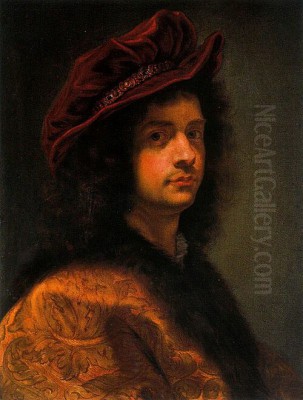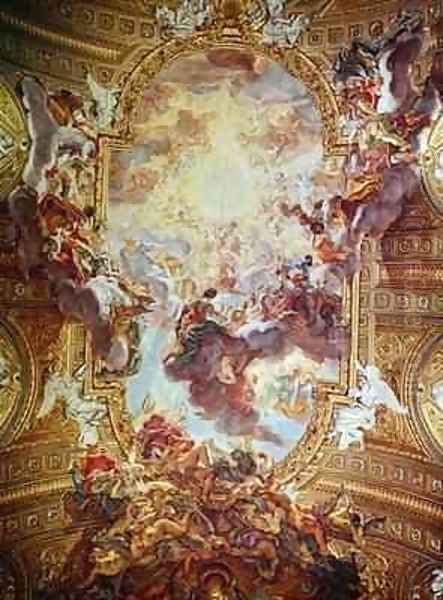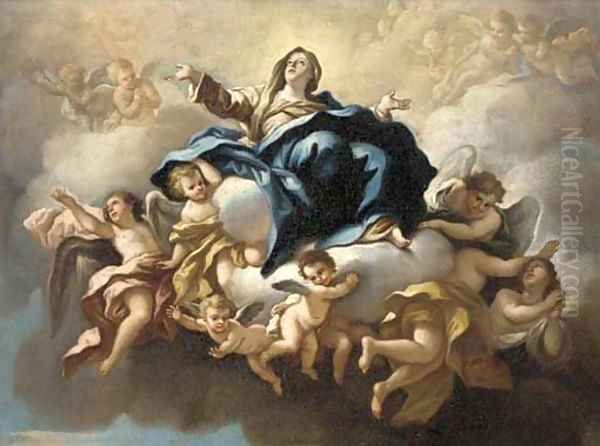
Giovanni Battista Gaulli, more famously known by his Genoese nickname "Baciccio" or "Baciccia," stands as a towering figure in the landscape of Italian High and Late Baroque art. Born in Genoa on May 8, 1639, and passing away in Rome on April 2, 1709, his career largely unfolded in the Eternal City, where he became one of the most sought-after painters, particularly renowned for his breathtaking illusionistic ceiling frescoes. His work represents a culmination of Baroque dynamism and theatricality, while also hinting at the lighter sensibilities of the emerging Rococo style.
Early Life and Genoese Formation
Gaulli's artistic journey began in his vibrant hometown of Genoa, a major maritime republic with a rich artistic tradition. His initial training was under the guidance of Luciano Borzone, a respected Genoese painter. This early formation would have exposed him to the local artistic currents, which included influences from Flemish masters like Peter Paul Rubens and Anthony van Dyck, who had previously worked in the city, leaving a significant mark on Genoese painting with their rich color and dynamic compositions. The artistic environment of Genoa provided a solid foundation before his pivotal move.
Around the mid-1650s, likely spurred by ambition and the desire to engage with the center of the art world, Gaulli relocated to Rome. This move, occurring around 1657, proved decisive for his career, placing him at the heart of Baroque innovation and patronage.
Arrival in Rome and the Mentorship of Bernini
Rome in the mid-17th century was an electrifying hub of artistic activity, dominated by the genius of Gian Lorenzo Bernini. Soon after arriving, Gaulli came into contact with this master sculptor, architect, and painter. Bernini quickly recognized the young Genoese painter's talent and took him under his wing. This relationship was more than just a standard apprenticeship; it was a profound mentorship and collaboration that shaped Gaulli's style and significantly boosted his career trajectory.

Bernini's influence on Gaulli was multifaceted. He imparted his understanding of dramatic composition, the integration of painting, sculpture, and architecture (the bel composto, or beautiful whole), and a dynamic approach to representing religious ecstasy and divine glory. Bernini's patronage and recommendation opened crucial doors for Gaulli, helping him secure important commissions and establish his reputation within the competitive Roman art scene.
The Ascent of Baciccio in Rome
Under Bernini's guidance and through his own burgeoning talent, Baciccio quickly gained recognition. His early Roman works began to showcase his ability to synthesize his Genoese training with the powerful Roman Baroque style. An important early commission came from the Collegio Romano, specifically for the church of Santa Marta al Collegio Romano.
Between 1662 and 1663, Gaulli painted works for Santa Marta, including a ceiling fresco depicting the Madonna and Child and altarpieces such as The Calling of Saint Matthew and The Death of St. Anthony. These works demonstrated his growing mastery of complex compositions and his ability to convey deep religious feeling, already hinting at the illusionistic potential he would later fully realize. Though one source suggests the Madonna e Santi (likely the Santa Marta ceiling) was not initially met with universal acclaim by its commissioners, these early projects solidified his presence in Rome.
Masterpiece: The Gesù Ceiling
Gaulli's fame reached its zenith with the commission to decorate the ceiling vault of the Church of the Gesù, the mother church of the Jesuit Order in Rome. This project, executed primarily between 1672 and 1685, remains his most celebrated achievement and a landmark of Baroque ceiling painting. The main fresco depicts the Triumph of the Name of Jesus, also often referred to as the Adoration of the Name of Jesus.
The Gesù ceiling is a breathtaking example of trompe-l'oeil painting, designed to create a powerful illusion of the heavens opening above the viewer. Gaulli employed the technique of quadratura (illusionistic architectural framing) and di sotto in sù (figures seen from below) to dissolve the physical boundary of the nave vault. Golden light emanates from the central IHS monogram (representing the name of Jesus), illuminating swirling clouds populated by a multitude of angels and saints ascending towards the divine radiance.

A key element of the illusion is how Gaulli extended the painted scene beyond the architectural frame, with figures appearing to spill over the gilded stucco work and cast shadows onto it. This seamless integration of painting and three-dimensional stucco figures (many executed by Bernini's collaborator, Antonio Raggi) exemplifies Bernini's concept of the bel composto. The effect is one of overwhelming movement, light, and spiritual drama, drawing the viewer into the celestial vision.
Contrasting with the heavenly glory, damned figures are depicted tumbling downwards into shadow on the edges of the composition, representing the Fall of the Damned. This juxtaposition enhances the central theme of the power and glory of Christ's name. The Gesù ceiling is not merely decorative; it is a powerful visual sermon embodying Jesuit theology and the Counter-Reformation spirit, designed to inspire awe and devotion. Its impact on subsequent church decoration throughout Europe was immense.
Artistic Style and Influences
Baciccio's style is firmly rooted in the High Baroque, characterized by its dynamism, emotional intensity, and theatricality. However, particularly in his later works, one can observe a softening of forms and a lighter palette that anticipates the Rococo. His mastery of illusionistic perspective, especially the di sotto in sù technique learned and perfected in Rome, was central to his large-scale frescoes.
He was a superb colorist, often employing warm, rich hues influenced by Venetian and Flemish traditions, particularly the work of Rubens and Van Dyck. This is evident in the vibrant energy of his figures and the atmospheric depth of his scenes. Gaulli also skillfully utilized chiaroscuro, the dramatic play of light and shadow, to model forms and enhance the emotional impact of his narratives. While less stark than Caravaggio's tenebrism, the influence of Caravaggio's revolutionary approach to light and realism can be felt, especially in the expressive intensity of Gaulli's figures.
His Genoese background remained an undercurrent in his work, perhaps contributing to a certain fluidity and decorative sensibility. He successfully blended these Northern Italian elements with the monumental grandeur of the Roman school, heavily shaped by Bernini's sculptural dynamism. Artists like Valerio Castello and Gregorio De Ferrari were part of the Genoese context from which he emerged. Gaulli's unique synthesis resulted in a style that was both powerful and elegant.
Other Major Commissions and Works
Beyond the Gesù, Gaulli undertook several other significant commissions in Rome. He contributed paintings, known as pendants, for the dome spandrels of Sant'Agnese in Agone in Piazza Navona, depicting virtues and allegorical figures, including the Glory of Saint Anne. These works further demonstrate his skill in integrating painting within a complex architectural setting, a project closely associated with the patronage of the Pamphili family and involving other prominent artists.
Another important fresco cycle was executed for the Basilica dei Santi Apostoli, depicting the Triumph of St. Francis Xavier. This work, while perhaps less revolutionary than the Gesù ceiling, confirmed his status as a leading painter of large-scale decorations. He also continued to produce altarpieces for various churches, such as The Martyrdom of Saint Dominic, showcasing his narrative abilities in more traditional formats. His preparatory drawings, like the sketch for Moses Surrounded by Angels, Putti, and Prophets, reveal his working process and his fluency in capturing complex figural arrangements. Works like The Crown of Solomon further attest to his engagement with diverse religious and historical subjects.
Baciccio as a Portraitist
While best known for his religious frescoes, Gaulli was also a highly accomplished portrait painter. He captured the likenesses of popes, cardinals, fellow artists, and members of the Roman aristocracy with remarkable psychological insight and technical finesse. His portraits often possess a sense of immediacy and liveliness, moving beyond mere formal representation to convey the sitter's character.
An interesting anecdote relates to Bernini's advice on portraiture. Bernini reportedly encouraged Gaulli to observe his sitters while they were engaged in conversation or activity, rather than posing rigidly. This method allowed the artist to capture more natural expressions and characteristic gestures, contributing to the vitality seen in many of Baciccio's portraits. Among his notable sitters were several Popes, including Clement IX, Clement X, Innocent XI, Alexander VIII, and Innocent XII, as well as a famous portrait of his mentor, Gian Lorenzo Bernini, and several insightful self-portraits.
Role in the Roman Art World
By the latter half of the 17th century, Baciccio was firmly established as one of Rome's leading painters. His success was recognized by his peers, and he held prestigious positions within the city's artistic institutions. He was an active member of the Accademia di San Luca, Rome's official academy of artists, and served as its Principe (Prince or Director) in 1673-1674, a testament to his high standing in the artistic community.
He played a significant role as a conduit between the artistic traditions of his native Genoa and the dominant Roman style. His presence enriched the Roman scene, while his success reflected the city's ability to attract and foster talent from across Italy and Europe. While highly acclaimed, his complex and ornate style sometimes drew discussion, particularly regarding the balance between decorative richness and devotional clarity, a common debate surrounding elaborate Baroque art. The immense influence of Bernini also led to considerations about the degree of Gaulli's artistic independence, though his unique synthesis of influences is undeniable.
Contemporaries and Artistic Context
Gaulli worked during a period of extraordinary artistic ferment in Rome. His career overlapped with, or followed closely upon, several giants of the Baroque era. His primary mentor, Bernini, was the undisputed leader. The legacy of Caravaggio, who had died decades earlier, still resonated powerfully in the use of dramatic lighting and realism.
Among his direct contemporaries in ceiling painting was Pietro da Cortona, whose Barberini ceiling (Triumph of Divine Providence) was another major landmark of Baroque illusionism, offering a slightly different, perhaps more classically structured approach compared to Gaulli's dynamism. Carlo Maratta was another leading painter, representing a more restrained, classicizing trend within the Baroque, often seen as an alternative to the high drama of artists like Gaulli and Cortona.
Andrea Pozzo, a Jesuit lay brother, became another master of illusionistic ceiling painting slightly later than Gaulli, creating famous works like the ceiling of Sant'Ignazio. Sculptors like Antonio Raggi and Ercole Ferrata, frequent collaborators of Bernini, worked alongside painters like Gaulli to create the integrated environments typical of High Baroque churches. Other notable painters active in Rome during parts of Gaulli's career included Ciro Ferri (Cortona's pupil) and the prolific Neapolitan painter Luca Giordano, known for his speed and vibrant style. This rich context of talent, patronage, and stylistic debate fueled the creative energy of the era.
Later Career and Legacy
In his later years, Gaulli's style continued to evolve, sometimes showing a greater softness and delicacy, hinting towards the Rococo. While he remained active, there might have been a shift towards more private commissions compared to the grand public projects of his middle career, possibly reflecting changing patterns of patronage in Rome towards the end of the 17th century. He continued to paint until his death in Rome in 1709.
Gaulli left a significant legacy through his students and followers. Among those documented as his pupils were Ludovico Mazzanti, Giovanni Odazzi, and Giovanni Battista Brughi. These artists helped to disseminate his style, carrying aspects of his approach to light, color, and composition into the 18th century.
However, his most profound influence came through his monumental works themselves, particularly the Gesù ceiling. It became a benchmark for illusionistic ceiling decoration, studied and emulated by artists across Europe undertaking similar large-scale decorative projects in churches and palaces. Baciccio secured his place in art history as a consummate master of the Baroque, capable of creating overwhelming visual experiences that merged technical virtuosity with profound spiritual expression.
Conclusion
Giovanni Battista Gaulli, "Baciccio," remains a pivotal figure in the story of Baroque art. From his Genoese origins, he rose to become one of Rome's most celebrated painters, largely through his extraordinary talent for illusionistic fresco painting and the crucial support of Gian Lorenzo Bernini. His ceiling frescoes, above all the breathtaking Triumph of the Name of Jesus in the Gesù, represent the pinnacle of Baroque theatricality and devotional art, dissolving architectural boundaries to create visions of celestial glory. As a master colorist, skilled portraitist, and influential teacher, Baciccio left an indelible mark on the art of his time and secured a lasting legacy in the annals of European painting.